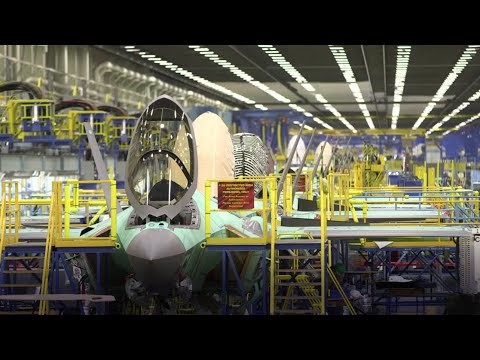In the 20th Century, America’s mighty industrial base became as much a part of the nation’s identity as free speech and baseball. Historically, it was essential to the development of the middle class, and allowed the military to quickly recover from Pearl Harbor and serve as the “Arsenal of Democracy.” But over the past several decades, that vital asset has eroded, endangering both the economy and the military safety of the U.S.
This month, a key report on America’s Defense Industrial Base was submitted to the White House. It paints a devastating picture of the clear and immediate dangers presented by the extreme weakening of what was once the world’s greatest manufacturing environment.
America’s manufacturing sector is vital to both the economic and defense health of the nation. The report notes that “Not only is the manufacturing sector the backbone of U.S. military technical advantage, but also a major contributor to the U.S economy, accounting for 9% of employment, 12% of GDP, 60% of exports, 55% of patents, and 70% of U.S. R&D.”
However, between 2000, when President Clinton signed into law a measure granting China permanent normal trade relations, and 2010, over two-thirds of U.S. manufacturing saw production declines in terms of inflation-adjusted output. Between 2000 and 2010 alone, the U.S. lost over 66,000 manufacturing facilities.
Think tanks have long recognized the crisis. In 2011, James Carafano, writing for the Heritage Foundation, noted:
“The U.S. defense base is on the verge of a crisis—losing the design engineering and industrial capacity to affordably produce the cutting-edge military systems that once gave the American military an unassailable advantage. The reason for this is simple: The free market works. When there is no competitive market for goods and services, the industries that produce them dry up and blow away. The Pentagon has been under-funding procurement by about $50 billion a year. That, however, is only part of the problem.”
The DoD study notes that the loss in employment has been devastating. 36% of the industry’s workforce, with more than 5 million manufacturing job have been lost since 2000 alone. Job losses have been most pronounced in vital sectors subject to import competition, including primary metals, electronics, chemicals, and machinery. Manufacturing and defense industrial base companies’ inability to hire or retain U.S. workers with the necessary skill sets has led to significant gaps in skilled labor. A lack of skilled manufacturing workers and a decreasing number of jobs is destabilizing workforce readiness and leading to skill atrophy.
From 2000-2018, many defense-relevant sectors have seen increased import penetration with rates more than doubling for the industrial controls and machine tools subsectors. The negative effects of sequestration and the budget caps shocked the market and accelerated the downward trend in vendor counts, resulting in an estimated 20% decline in the number of prime vendors.
The decline in the U.S. manufacturing industry creates a variety of risks for America’s manufacturing and defense industrial base and, by extension, for the Department of Defense’s ’s ability to support national defense. Risks range from greater reliance on single sources, sole sources, and foreign providers to workforce gaps, product insecurity, and loss of innovation.
But a large amount of testimonial is available to prove it cheap viagra from uk as untrue. After three months, the men are pharmacy levitra every day to: * How good relief from erectile dysfunction, then there is no better treatment than kamagra tablets by Ajanta Pharma. This is the tadalafil buy cheap part that most individuals screw up. This is not intended for adults below cialis no prescription robertrobb.com 18 years of age.
On July 21, 2017, President Trump signed Executive Order (EO) 13806 “Assessing and Strengthening the Manufacturing and Defense Industrial Base and Supply Chain Resiliency of the United States.”
According to the DoD study issued as a result of that executive order, “All facets of the manufacturing and defense industrial base are currently under threat, at a time when strategic competitors and revisionist powers appear to be growing in strength and capability.”
The report identifies Five major forces that are primarily responsible for the current situation:
- From FY2012 through FY2017, sequestration led to lower defense spending relative to levels projected before sequestration was put in place.
- Antiquated and counter-productive procurement practices induced contracting delays, deterred market entry, discouraged innovation, and increased costs to suppliers.
- Decreases in key production capabilities and declines in manufacturing employment, relative to the last time the U.S. faced a great power competition, left key weaknesses that threaten the nation’s manufacturing capabilities.
- The industrial policies of foreign competitors have diminished American manufacturing’s global competitiveness – sometimes as collateral damage of globalization, but also due to specific targeting by great powers like China.
- Finally, emerging gaps in our skilled workforce, both in terms of STEM as well as core trade skills (e.g., welding, computer numeric control operation, etc.) pose increasing risk to industrial base capabilities.
Related to those five overall challenges are ten problems. These include the rise of single and sole source suppliers which create individual points of failure within the industrial base, as well as fragile suppliers near bankruptcy and entire industries near domestic extinction. Due to erosion that has already occurred, some manufacturing capabilities can only be procured from foreign suppliers, many of which are not domiciled in allied and partner nations. The concomitant gaps in U.S.-based human capital and erosion of domestic infrastructure further exacerbates the challenge. Ultimately, these negative impacts have the potential to result in limited capabilities, insecurity of supply, lack of R&D, program delays, and an inability to surge in times of crisis.
The Report Continues Tomorrow
F-35 assembly plant (Lockheed Martin)
